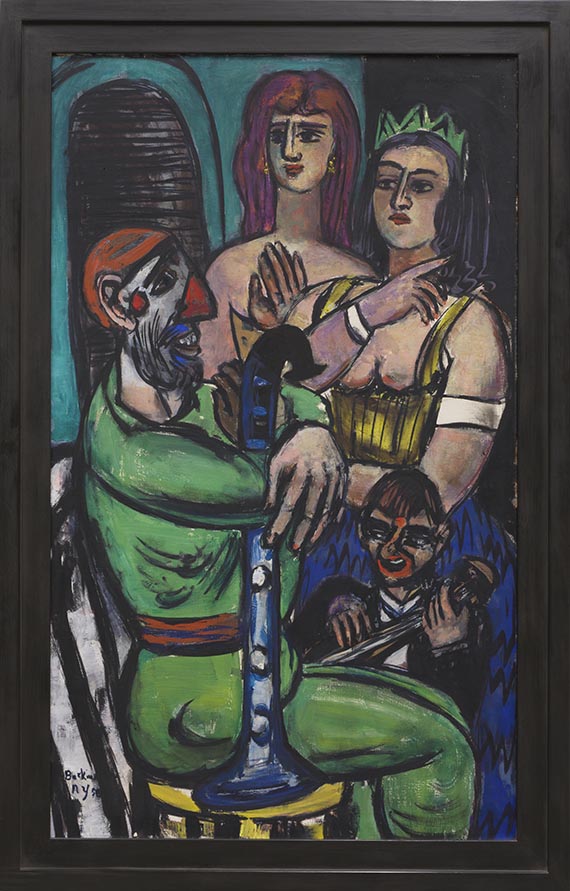23
Max Beckmann
Großer Clown mit Frauen und kleiner Clown, 1950.
Olio su tela
Stima:
€ 1,400,000 / $ 1,582,000 Risultato:
€ 3,678,000 / $ 4,156,139 ( commissione inclusa)
Großer Clown mit Frauen und kleiner Clown. 1950.
Oil on canvas.
Signed and dated "NY [=New York] 50" in the lower left. 128 x 77 cm (50.3 x 30.3 in).
Literature identifies the painting by various titles, including "Clown mit Frauen und kleiner Clown" (Clown with Women and Little Clown), "Harlekin" (Harlequin), "Grüner Harlekin" (Green Harlequin) and "Grüner Clown" (Green Clown). Beckmann lists the painting, on which he worked from October 1949 to September 1950, in his list of pictures with the following entry: “1949 New York, 21 King [crossed out] gr Clown with women and k. Clown Pompei [crossed out] started Oct. 11 finished Sept. 2”. On November 21, 1950, Beckmann mentioned the painting one last time in his diary, noting that he had worked on the “green clown” again after a walk in Central Park. [JS].
• The clown as an alter ego in Beckmann's “World Theater”: From “Self-portrait as a Clown” (1921) to “Großer Clown mit Frauen” (1950), Beckmann repeatedly took on this role.
• “Clown mit Frauen”: an artistic legacy and emotional allegory of Beckmann's tragic life in exile.
• A skillful combination of Beckmann's central themes: self-reflection, the world as a stage, and life as a journey.
• Painted around the same time as the famous last triptych, “The Argonauts” (1950, National Gallery of Art, Washington), likewise considered an artistic legacy.
• One of Beckmann's last paintings on which he worked until the end of November 1950; he died on December 27, 1950, on a walk in Central Park.
• Long history of international exhibitions.
• Part of the outstanding collection of Berthold and Else Beitz, Essen, for almost 60 years.
PROVENANCE: Estate of the artist
Mathilde Q. Beckmann (since December 27, from the estate in 1950)
Curt Valentin /Buchholz Gallery, New York (1951, presumably on commission).
Dr. Peter Beckmann, Gauting (around 1955/56).
Dr. Hans Sommer, Wertingen (after 1957)
Berthold and Else Beitz Collection, Essen (since 1965).
Since then in family ownership.
EXHIBITION: Max Beckmann, Curt Valentin / Buchholz Gallery, New York, April 3 - 28, 1951, cat. no. 17 illustrated, here with the title “The Green Clown”).
Deutsche Kunst. Meisterwerke des 20. Jahrhunderts, Kunstmuseum, Lucerne, July 4 - October 2, 1953, cat. no. 238.
Max Beckmann 1884-1950. Gedächtnisausstellung, Werke aus 5 Jahrzehnten, Kunstverein Städtisches Museum and Haus Salve Hospes, Brunswick, October 25 - November 22, 1953 / Kunsthalle, Bremen, November 29, 1953 - January 3, 1954, cat. no. 71.
Max Beckmann, Kunst und Kunstgewerbeverein Pforzheim e.V., Pfortzheim, March 7-28, 1954, cat. no. 37.
Max Beckmann, Kunsthalle, Basel, January 14 - February 12, 1956, cat. no. 126.
Max Beckmann 1884-1950. Gedächtnisausstellung, Städtische Galerie, Würzburg, March 1956, cat. no. 6.
Arte tedesca dal 1905 ad oggi, Quadriennale Nazionale d'Arte di Roma, Rome / Ente Manifestazioni Milanesi, Milan, 1957, cat. no. 19.
50 Jahre Museum Folkwang in Essen, Freunde des Museums sammeln. Drei Ausstellungen aus dem Besitz von Mitgliedern des Folkwang-Museumsvereins e.V., 20. June 4 - 23, 1972, cat. no. 4 (illustrated)
Max Beckmann, Kunsthalle Bielefeld, November 2 - December 14, 1975.
Max Beckmann, Josef-Haubrich-Kunsthalle, Cologne, April 19 - June 24, 1984.
Max Beckmann. Gemälde 1905-1950, Museum der Bildenden Künste, Leipzig / Städel Museum, Frankfurt a. M., July 21 - September 23, 1990.
“Expressiv!”, Fondation Beyerle, Riehen, March 30 – August 10, 2003, p. 188 (illustrated on p. 125).
Museum Folkwang, Essen (on permanent loan from a private collection since 2015).
Max Beckmann. Welttheater, Kunsthalle Bremen, July 30, 2017 - February 4, 2018 / Museum Barberini, Potsdam, January 24 - June 10, 2018, cat. no. 62.
LITERATURE: Anja Tiedemann, Kaldewei Kulturstiftung (ed.), Werkverzeichnis Max Beckmann - Catalogue Raisonné of Paintings, Frankfurt a. Main, online catalog no. 828.
Barbara and Erhard Göpel, Max Beckmann. Katalog der Gemälde, vol. 1, Bern 1976, catalog no. 828.
- -
Erhard Göpel, Max Beckmann. Die Argonauten - Ein Tryptichon, Stuttgart 1957, pp. 58 and 63 (with fig. no. 3 and fig. 43/44 (details)).
Friedhelm Wilhelm Fischer, Max Beckmann. Symbol und Weltbild. Grundriss zu einer Deutung des Gesamtwerkes, Munich, 1972, p. 201.
Erhard Göpel (ed.), Max Beckmann, Tagebücher 1940-1950 (compiled by Mathilde Q. Beckmann), Munich, 1984, mention of the painting on November 3, 8, 11, 26, 27, 1949 and November 21, 1950 (see also January 21, 1950 and possibly also October 9, 1950).
"He repeatedly grappled with this important work, not least because it represents a summary of his life in so many ways."
Dr. Christiane Zeiller, Max Beckmann Archive
"If you look at all of this – the war or just life itself – as just a scene on the stage of the Theater of Infinity, many things become so much easier to bear."
Max Beckmann, journal, September 12, 1940
"All the roles Beckmann played on the stage of 'Welttheater', all the deaths he has died [..] isn't this ultimately the only way to salvage oneself from the undifferentiated mass [..] as part of an infinite whole?“
Carla Schultze Hoffmann, quoted from: Max Beckmann, Selbstbildnisse, Munich 1993, p. 27.
“Alongside Pablo Picasso and Francis Bacon, Max Beckmann stands out as one of the greatest, indeed most elementary painters of the artistically rich 20th century.”
Berhad Maaz, General Director of the Bayerische Gemäldesammlungen.
Quoted from: ex. cat. Departure, Pinakothek der Moderne, Munich 2022, p. 13.
Oil on canvas.
Signed and dated "NY [=New York] 50" in the lower left. 128 x 77 cm (50.3 x 30.3 in).
Literature identifies the painting by various titles, including "Clown mit Frauen und kleiner Clown" (Clown with Women and Little Clown), "Harlekin" (Harlequin), "Grüner Harlekin" (Green Harlequin) and "Grüner Clown" (Green Clown). Beckmann lists the painting, on which he worked from October 1949 to September 1950, in his list of pictures with the following entry: “1949 New York, 21 King [crossed out] gr Clown with women and k. Clown Pompei [crossed out] started Oct. 11 finished Sept. 2”. On November 21, 1950, Beckmann mentioned the painting one last time in his diary, noting that he had worked on the “green clown” again after a walk in Central Park. [JS].
• The clown as an alter ego in Beckmann's “World Theater”: From “Self-portrait as a Clown” (1921) to “Großer Clown mit Frauen” (1950), Beckmann repeatedly took on this role.
• “Clown mit Frauen”: an artistic legacy and emotional allegory of Beckmann's tragic life in exile.
• A skillful combination of Beckmann's central themes: self-reflection, the world as a stage, and life as a journey.
• Painted around the same time as the famous last triptych, “The Argonauts” (1950, National Gallery of Art, Washington), likewise considered an artistic legacy.
• One of Beckmann's last paintings on which he worked until the end of November 1950; he died on December 27, 1950, on a walk in Central Park.
• Long history of international exhibitions.
• Part of the outstanding collection of Berthold and Else Beitz, Essen, for almost 60 years.
PROVENANCE: Estate of the artist
Mathilde Q. Beckmann (since December 27, from the estate in 1950)
Curt Valentin /Buchholz Gallery, New York (1951, presumably on commission).
Dr. Peter Beckmann, Gauting (around 1955/56).
Dr. Hans Sommer, Wertingen (after 1957)
Berthold and Else Beitz Collection, Essen (since 1965).
Since then in family ownership.
EXHIBITION: Max Beckmann, Curt Valentin / Buchholz Gallery, New York, April 3 - 28, 1951, cat. no. 17 illustrated, here with the title “The Green Clown”).
Deutsche Kunst. Meisterwerke des 20. Jahrhunderts, Kunstmuseum, Lucerne, July 4 - October 2, 1953, cat. no. 238.
Max Beckmann 1884-1950. Gedächtnisausstellung, Werke aus 5 Jahrzehnten, Kunstverein Städtisches Museum and Haus Salve Hospes, Brunswick, October 25 - November 22, 1953 / Kunsthalle, Bremen, November 29, 1953 - January 3, 1954, cat. no. 71.
Max Beckmann, Kunst und Kunstgewerbeverein Pforzheim e.V., Pfortzheim, March 7-28, 1954, cat. no. 37.
Max Beckmann, Kunsthalle, Basel, January 14 - February 12, 1956, cat. no. 126.
Max Beckmann 1884-1950. Gedächtnisausstellung, Städtische Galerie, Würzburg, March 1956, cat. no. 6.
Arte tedesca dal 1905 ad oggi, Quadriennale Nazionale d'Arte di Roma, Rome / Ente Manifestazioni Milanesi, Milan, 1957, cat. no. 19.
50 Jahre Museum Folkwang in Essen, Freunde des Museums sammeln. Drei Ausstellungen aus dem Besitz von Mitgliedern des Folkwang-Museumsvereins e.V., 20. June 4 - 23, 1972, cat. no. 4 (illustrated)
Max Beckmann, Kunsthalle Bielefeld, November 2 - December 14, 1975.
Max Beckmann, Josef-Haubrich-Kunsthalle, Cologne, April 19 - June 24, 1984.
Max Beckmann. Gemälde 1905-1950, Museum der Bildenden Künste, Leipzig / Städel Museum, Frankfurt a. M., July 21 - September 23, 1990.
“Expressiv!”, Fondation Beyerle, Riehen, March 30 – August 10, 2003, p. 188 (illustrated on p. 125).
Museum Folkwang, Essen (on permanent loan from a private collection since 2015).
Max Beckmann. Welttheater, Kunsthalle Bremen, July 30, 2017 - February 4, 2018 / Museum Barberini, Potsdam, January 24 - June 10, 2018, cat. no. 62.
LITERATURE: Anja Tiedemann, Kaldewei Kulturstiftung (ed.), Werkverzeichnis Max Beckmann - Catalogue Raisonné of Paintings, Frankfurt a. Main, online catalog no. 828.
Barbara and Erhard Göpel, Max Beckmann. Katalog der Gemälde, vol. 1, Bern 1976, catalog no. 828.
- -
Erhard Göpel, Max Beckmann. Die Argonauten - Ein Tryptichon, Stuttgart 1957, pp. 58 and 63 (with fig. no. 3 and fig. 43/44 (details)).
Friedhelm Wilhelm Fischer, Max Beckmann. Symbol und Weltbild. Grundriss zu einer Deutung des Gesamtwerkes, Munich, 1972, p. 201.
Erhard Göpel (ed.), Max Beckmann, Tagebücher 1940-1950 (compiled by Mathilde Q. Beckmann), Munich, 1984, mention of the painting on November 3, 8, 11, 26, 27, 1949 and November 21, 1950 (see also January 21, 1950 and possibly also October 9, 1950).
"He repeatedly grappled with this important work, not least because it represents a summary of his life in so many ways."
Dr. Christiane Zeiller, Max Beckmann Archive
"If you look at all of this – the war or just life itself – as just a scene on the stage of the Theater of Infinity, many things become so much easier to bear."
Max Beckmann, journal, September 12, 1940
"All the roles Beckmann played on the stage of 'Welttheater', all the deaths he has died [..] isn't this ultimately the only way to salvage oneself from the undifferentiated mass [..] as part of an infinite whole?“
Carla Schultze Hoffmann, quoted from: Max Beckmann, Selbstbildnisse, Munich 1993, p. 27.
“Alongside Pablo Picasso and Francis Bacon, Max Beckmann stands out as one of the greatest, indeed most elementary painters of the artistically rich 20th century.”
Berhad Maaz, General Director of the Bayerische Gemäldesammlungen.
Quoted from: ex. cat. Departure, Pinakothek der Moderne, Munich 2022, p. 13.
'I am a silly old clown and nothing else [..]'
Max Beckmann, diary entry on April 18, 1946.
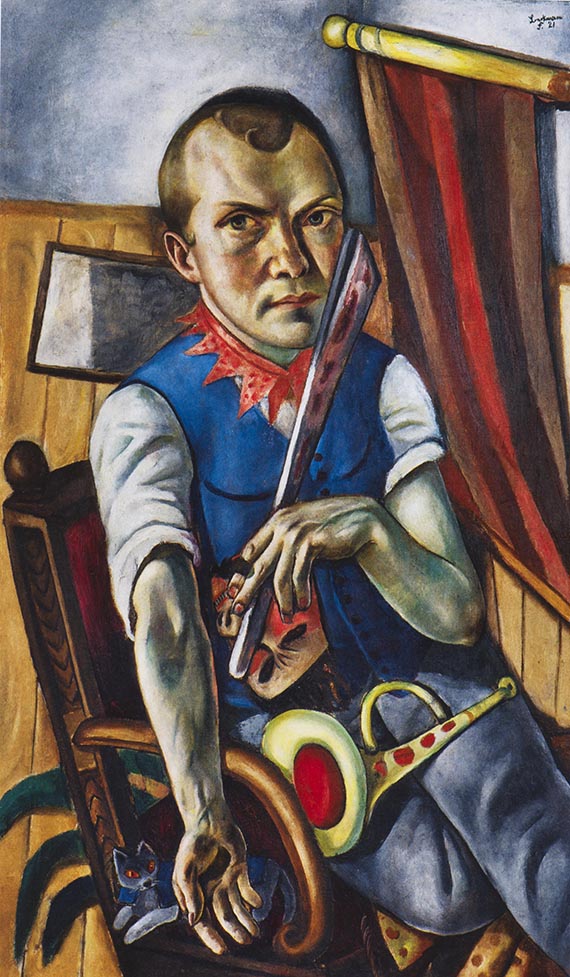
Many self-portraits characterize Max Beckmann's oeuvre, while masks and costumes are recurring motifs. In addition to the classic self-portrait genre, this group includes paintings that show him more or less hidden and “masked”, taking on different roles. The world of the circus constitutes a kind of basso continuo that runs like a red thread through his artistic work. Beckmann's “Self-Portrait as Clown” from 1921 already professes the role in the title that one, entirely unadorned, does not want to accept for the tormented artist. His self-portraits as “Acrobat in a Swing” (1940, Saint Louis Art Museum) or as Harlequin in the center panel of the triptych “Carnival” (1943, Iowa City Museum of Art) are more challenging to recognize. Time and again, the painter is immersed in the fascinating world of the circus, the stage, and what goes on behind the scenes, especially in the dressing rooms, where the “transformation” takes place.
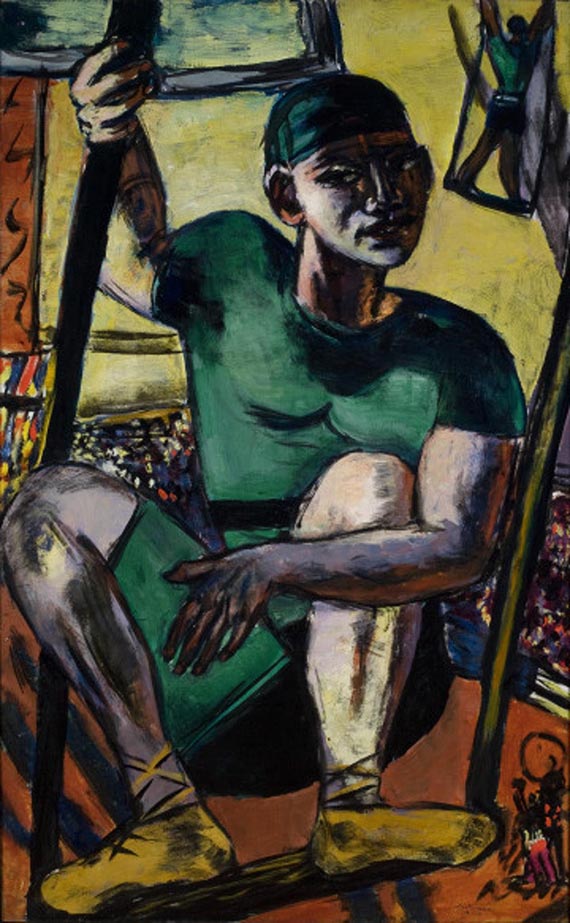
In this magnificent painting, “Clown mit Frauen und Kleiner Clown” (Clown with Women and Little Clown), the artist can be recognized in the main character, the red-nosed clown dressed in green on the right. With his intention to make the audience laugh, the clown's grin freezes like a mask as he clutches his instrument in search of support, as if he needed protection from the three figures closing in on him. The two female figures, with their ambiguous appeal, and the clown, who is small in stature and attracts attention by playing loud music, are explicitly focused on the main character. The two women are young American women of the type that Beckmann encountered in his everyday life, for example, in his lessons at the Brooklyn Museum Art School. Their youth and beauty starkly contrast the aged clown behind whom darkness lies.
The woman on the right, who seems to command the clown to leave, is reminiscent of the Statue of Liberty with her verdigris-colored hair ornament. As the goddess of fate, she decides who can stay (in the USA) and who must leave the country. She is an expression of the painter's persistent anxiety due to his residence permit having been repeatedly queried since he first came to the USA in September 1947, even though he had found permanent employment and an apartment in New York City, the metropolis of millions, between misery, big city noise and sparkling lights. The second woman with reddish-purple hair and the small clown seem like assistants to the crowned woman in the golden-royal blue robe. The color palette appears gaudy and fresh, reflecting Beckmann's most recent encounters with New York's neon signs and modern Technicolor cinema.
Max Beckmann began working on the painting after settling in his new residence in the fall of 1949. The painter was severely exhausted and had been suffering from a steadily worsening heart condition for some time. Nevertheless, he taught several summer courses in Boulder, Colorado, for two and a half months and continued his arduous teaching activities in New York. Almost every day, he was confronted with the contrast between his physical decline and a flourishing American youth unburdened by the war.
While working on the piece, which kept Beckmann busy for over a year with a few interruptions, he expressed the difficulty of capturing the clown in his diary entry on November 8, 1949: “Still working hard on the clowns. More work than I expected. It is challenging to capture a clown because of his exaggerated physicality.” He grappled with this vital work repeatedly, not least because it reflects his situation in many ways. A few weeks before his death, he took on the painting one last time, and on November 21, 1950, he noted in his diary: “Then (against my will) three hours (after a year) on the old green clown. Quite beautiful.”
This is the last time this work has been mentioned. On December 27, 1950, Max Beckmann died on a walk in New York.
Dr. Christiane Zeiller, Max Beckmann Archive
The Max Beckmann Archive at the Bavarian State Painting Collections in Munich is currently preparing a complete digital edition of Max Beckmann's diaries. Dr. Nina Peter and Dr. Christiane Zeiller, under the direction of Dr. Oliver Kase, are editing the edition scheduled for release in 2025.
___
"Großer Clown mit Frauen" (1950) – Max Beckmann's artistic legacy
Max Beckmann's “Großer Clown mit Frauen” (Large Clown with Women) is not just one of the artist's last paintings - it is an artistic legacy, a mysterious and deeply personal allegory of life. Painted in 1950, shortly before Beckmann's sudden death in New York, the artist presents himself one last time as the clown, his famous alter ego. It was in 1921 that Beckmann first slipped into the role of the humorous commentator on our tragic-comic existence in his “Self-Portrait as a Clown” (Von der Heydt-Museum, Wuppertal). In his multifaceted painterly “Welttheater", inspired by the circus world, Beckmann repeatedly portrayed himself as a clown, harlequin, or circus artist. In “Large Clown with Women”, his last, highly intricate self-portrait of this kind, Beckmann once again combined the central themes of his oeuvre in a single, vigorous composition: his inexhaustible, almost obsessive painterly self-reflection, his distanced view of the world as a stage and life as a scene in the great “World Theater”, as well as his artistic examination of his life in exile.
Beckmann's last leading role – “Large Clown with Women” as a revealing alter ego and allegory of life
Fascinated with the worlds of theater and circus, both of which Beckmann frequently visited, the artist primarily identified with the role of the clown, the humorous commentator on our tragic-comic existence. “Looking at all of this - the war or just life itself - like a show on the stage of the Theater of Infinity, many things become easier to bear,” Max Beckmann noted in his diary in exile in Amsterdam on September 12, 1940. This famous quote has the quality of an artistic comment on the dense and fascinating composition that Beckmann would create ten years later. After settling in his new New York home, he created this fascinating painting. It is a final impressive pinnacle of his captivating “world theater.”
Many of Beckmann's paintings were seized from German museums during the reign of the National Socialist and shown in the 1937 propaganda exhibition “Degenerate Art” at the Munich Hofgarten. On the day Hitler's speech on the occasion of the opening of a simultaneous exhibition at the Haus der Kunst in Munich was broadcast, Beckmann left Germany for good. Without further ado, the artist and his wife Mathilde (known as Quappi) packed up and set off to visit relatives in Amsterdam. What was disguised as a vacation trip led to one of the most profound changes in Beckmann's life. Living in Amsterdam, Beckmann applied for a visa to the USA as early as 1939. However, it was only after ten years in Dutch exile that the artist and his wife were eventually granted entry to the USA in the summer of 1947, where Beckmann initially had a teaching post at the School of Arts at Washington University in St. Louis before he settled in New York in the summer of 1949.
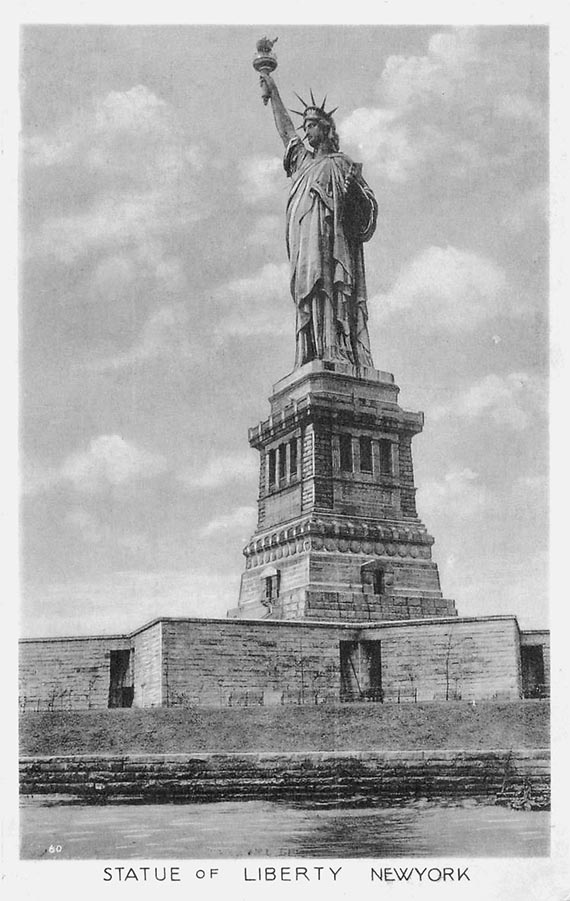
Just four days after he arrived in the East Coast metropolis, Beckmann visited the Museum of Modern Art to see his triptych “Departure” (1932-1935), which he had begun in Germany and which was acquired by the MoMA in 1942, five years before Beckmann's immigration. “The 'Departure' has become one of the most popular paintings in America. Everyone knows it,” Beckmann proudly wrote to his divorced first wife Minna in 1949. Now that he had finally settled in his new home in New York, Beckmann soon began to work on “Large Clown with Women”, a complex and emotional allegory of his life. As recorded in his diary, he eventually completed it after more than a year on November 21, 1950. Just a few weeks later, Beckmann, one of the most important German artists of the 20th century, died suddenly and unexpectedly during a walk in Central Park.
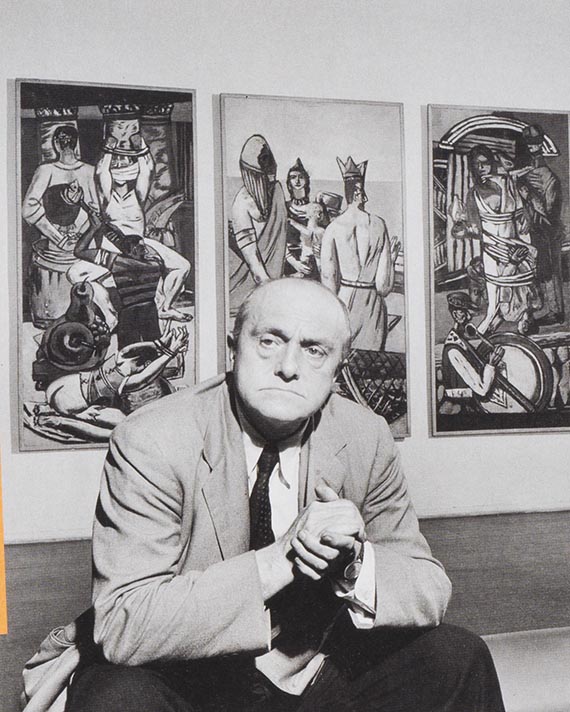
Beckmann in New York - new beginnings, attractions and rejections, freedom and isolation
Beckmann liberated his troubled soul from emotional turmoil by creating a composition so full of meaning and, at the same time, largely enigmatic. In “Large Clown with Women,” the artist performs one last time as the clown on the grand stage of his inimitable “world theater.” With the two female figures, Beckmann accompanied his alter ego with two puzzling personifications that are representative of Beckmann's last chapter of life in America and embody his complex emotional situation and his feeling of being torn about his new homeland, which the artist perceives as both enticing and repellent, liberating and threatening. While Beckmann was forced to leave Germany and his paintings had already made their way into American museums, the artist was increasingly struggling with the American metropolis's noise and climate.
The right female figure, apparently commanding the clown to leave, clearly references the Statue of Liberty, the promising symbol of America that welcomes hopeful travelers upon their arrival at New York Harbor. On Beckmann's stage, however, she is rendered as a goddess of destiny that decides who is allowed to enter and who may have to leave the country. As such, she is the artistic expression of Beckmann's persistent anxiety that his residence permit might be revoked, as it had been repeatedly questioned since his entry into the USA in September 1947.
He had finally found permanent employment as well as a permanent residence in New York, the exciting and, at times, overwhelming metropolis of millions, with its strangely fascinating but at the same time daunting aura. While ladies, fashion, and nightlife are glamorous and provocative, the climate and social atmosphere are harsh. Moreover, the agonizing thoughts of Germany, which he had to leave so hastily in 1937, remain present in New York, when Beckmann noted in his diary in 1950: “Piper sent his Beckmann memoirs, quite amusing, had to laugh about me now and then. Funny, now that I'm no longer there, I'm starting to live in Germany.” (quoted from: ex. cat. Max Beckmann. Selbstbildnisse, Munich 1993, p. 122).
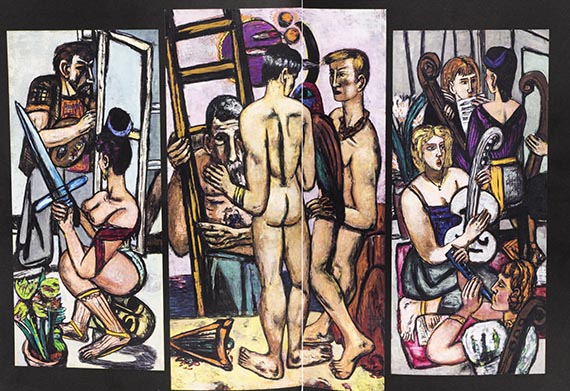
Beyond all these personal references, Beckmann also successfully captured the big existential questions of our existence on canvas in this highly complex composition, addressing the themes of youth and old age, longing and hopelessness, attraction and rejection. A few weeks after completing this outstanding artistic legacy, Beckmann died in New York on December 27, 1950. Beckmann‘s wife “Quappi” was the first to own the painting, after which it passed into the possession of Beckmann‘s son Peter.
Since 1965, it has been part of a high-profile German private collection of expressionist masterpieces in the Ruhr region. Over the past decades, “Tall Clown with Women” has been on loan from this collection for numerous important exhibitions, including the major exhibition “Max Beckmann. Welttheater” in 2018, most recently on permanent loan at the Folkwang Museum, Essen. [MvL/JS]
Max Beckmann, diary entry on April 18, 1946.

Max Beckmann, Selbstbildnis als Clown, 1921, oil on canvas, Von der Heydt-Museum Wuppertal.
Many self-portraits characterize Max Beckmann's oeuvre, while masks and costumes are recurring motifs. In addition to the classic self-portrait genre, this group includes paintings that show him more or less hidden and “masked”, taking on different roles. The world of the circus constitutes a kind of basso continuo that runs like a red thread through his artistic work. Beckmann's “Self-Portrait as Clown” from 1921 already professes the role in the title that one, entirely unadorned, does not want to accept for the tormented artist. His self-portraits as “Acrobat in a Swing” (1940, Saint Louis Art Museum) or as Harlequin in the center panel of the triptych “Carnival” (1943, Iowa City Museum of Art) are more challenging to recognize. Time and again, the painter is immersed in the fascinating world of the circus, the stage, and what goes on behind the scenes, especially in the dressing rooms, where the “transformation” takes place.

Max Beckmann, Akrobat auf der Schaukel, 1940, oil on canvas, Saint Louis Art Museum.
In this magnificent painting, “Clown mit Frauen und Kleiner Clown” (Clown with Women and Little Clown), the artist can be recognized in the main character, the red-nosed clown dressed in green on the right. With his intention to make the audience laugh, the clown's grin freezes like a mask as he clutches his instrument in search of support, as if he needed protection from the three figures closing in on him. The two female figures, with their ambiguous appeal, and the clown, who is small in stature and attracts attention by playing loud music, are explicitly focused on the main character. The two women are young American women of the type that Beckmann encountered in his everyday life, for example, in his lessons at the Brooklyn Museum Art School. Their youth and beauty starkly contrast the aged clown behind whom darkness lies.
The woman on the right, who seems to command the clown to leave, is reminiscent of the Statue of Liberty with her verdigris-colored hair ornament. As the goddess of fate, she decides who can stay (in the USA) and who must leave the country. She is an expression of the painter's persistent anxiety due to his residence permit having been repeatedly queried since he first came to the USA in September 1947, even though he had found permanent employment and an apartment in New York City, the metropolis of millions, between misery, big city noise and sparkling lights. The second woman with reddish-purple hair and the small clown seem like assistants to the crowned woman in the golden-royal blue robe. The color palette appears gaudy and fresh, reflecting Beckmann's most recent encounters with New York's neon signs and modern Technicolor cinema.
Max Beckmann began working on the painting after settling in his new residence in the fall of 1949. The painter was severely exhausted and had been suffering from a steadily worsening heart condition for some time. Nevertheless, he taught several summer courses in Boulder, Colorado, for two and a half months and continued his arduous teaching activities in New York. Almost every day, he was confronted with the contrast between his physical decline and a flourishing American youth unburdened by the war.
While working on the piece, which kept Beckmann busy for over a year with a few interruptions, he expressed the difficulty of capturing the clown in his diary entry on November 8, 1949: “Still working hard on the clowns. More work than I expected. It is challenging to capture a clown because of his exaggerated physicality.” He grappled with this vital work repeatedly, not least because it reflects his situation in many ways. A few weeks before his death, he took on the painting one last time, and on November 21, 1950, he noted in his diary: “Then (against my will) three hours (after a year) on the old green clown. Quite beautiful.”
This is the last time this work has been mentioned. On December 27, 1950, Max Beckmann died on a walk in New York.
Dr. Christiane Zeiller, Max Beckmann Archive
The Max Beckmann Archive at the Bavarian State Painting Collections in Munich is currently preparing a complete digital edition of Max Beckmann's diaries. Dr. Nina Peter and Dr. Christiane Zeiller, under the direction of Dr. Oliver Kase, are editing the edition scheduled for release in 2025.
___
"Großer Clown mit Frauen" (1950) – Max Beckmann's artistic legacy
Max Beckmann's “Großer Clown mit Frauen” (Large Clown with Women) is not just one of the artist's last paintings - it is an artistic legacy, a mysterious and deeply personal allegory of life. Painted in 1950, shortly before Beckmann's sudden death in New York, the artist presents himself one last time as the clown, his famous alter ego. It was in 1921 that Beckmann first slipped into the role of the humorous commentator on our tragic-comic existence in his “Self-Portrait as a Clown” (Von der Heydt-Museum, Wuppertal). In his multifaceted painterly “Welttheater", inspired by the circus world, Beckmann repeatedly portrayed himself as a clown, harlequin, or circus artist. In “Large Clown with Women”, his last, highly intricate self-portrait of this kind, Beckmann once again combined the central themes of his oeuvre in a single, vigorous composition: his inexhaustible, almost obsessive painterly self-reflection, his distanced view of the world as a stage and life as a scene in the great “World Theater”, as well as his artistic examination of his life in exile.
Beckmann's last leading role – “Large Clown with Women” as a revealing alter ego and allegory of life
Fascinated with the worlds of theater and circus, both of which Beckmann frequently visited, the artist primarily identified with the role of the clown, the humorous commentator on our tragic-comic existence. “Looking at all of this - the war or just life itself - like a show on the stage of the Theater of Infinity, many things become easier to bear,” Max Beckmann noted in his diary in exile in Amsterdam on September 12, 1940. This famous quote has the quality of an artistic comment on the dense and fascinating composition that Beckmann would create ten years later. After settling in his new New York home, he created this fascinating painting. It is a final impressive pinnacle of his captivating “world theater.”
Many of Beckmann's paintings were seized from German museums during the reign of the National Socialist and shown in the 1937 propaganda exhibition “Degenerate Art” at the Munich Hofgarten. On the day Hitler's speech on the occasion of the opening of a simultaneous exhibition at the Haus der Kunst in Munich was broadcast, Beckmann left Germany for good. Without further ado, the artist and his wife Mathilde (known as Quappi) packed up and set off to visit relatives in Amsterdam. What was disguised as a vacation trip led to one of the most profound changes in Beckmann's life. Living in Amsterdam, Beckmann applied for a visa to the USA as early as 1939. However, it was only after ten years in Dutch exile that the artist and his wife were eventually granted entry to the USA in the summer of 1947, where Beckmann initially had a teaching post at the School of Arts at Washington University in St. Louis before he settled in New York in the summer of 1949.

Statue of Liberty, New York City, postcard from the 1940s.
Just four days after he arrived in the East Coast metropolis, Beckmann visited the Museum of Modern Art to see his triptych “Departure” (1932-1935), which he had begun in Germany and which was acquired by the MoMA in 1942, five years before Beckmann's immigration. “The 'Departure' has become one of the most popular paintings in America. Everyone knows it,” Beckmann proudly wrote to his divorced first wife Minna in 1949. Now that he had finally settled in his new home in New York, Beckmann soon began to work on “Large Clown with Women”, a complex and emotional allegory of his life. As recorded in his diary, he eventually completed it after more than a year on November 21, 1950. Just a few weeks later, Beckmann, one of the most important German artists of the 20th century, died suddenly and unexpectedly during a walk in Central Park.

Max Beckmann at the Museum of Modern Art, New York, in front of his triptych “Depature“, 1947, photo: Geoffrey Clements.
Beckmann in New York - new beginnings, attractions and rejections, freedom and isolation
Beckmann liberated his troubled soul from emotional turmoil by creating a composition so full of meaning and, at the same time, largely enigmatic. In “Large Clown with Women,” the artist performs one last time as the clown on the grand stage of his inimitable “world theater.” With the two female figures, Beckmann accompanied his alter ego with two puzzling personifications that are representative of Beckmann's last chapter of life in America and embody his complex emotional situation and his feeling of being torn about his new homeland, which the artist perceives as both enticing and repellent, liberating and threatening. While Beckmann was forced to leave Germany and his paintings had already made their way into American museums, the artist was increasingly struggling with the American metropolis's noise and climate.
The right female figure, apparently commanding the clown to leave, clearly references the Statue of Liberty, the promising symbol of America that welcomes hopeful travelers upon their arrival at New York Harbor. On Beckmann's stage, however, she is rendered as a goddess of destiny that decides who is allowed to enter and who may have to leave the country. As such, she is the artistic expression of Beckmann's persistent anxiety that his residence permit might be revoked, as it had been repeatedly questioned since his entry into the USA in September 1947.
He had finally found permanent employment as well as a permanent residence in New York, the exciting and, at times, overwhelming metropolis of millions, with its strangely fascinating but at the same time daunting aura. While ladies, fashion, and nightlife are glamorous and provocative, the climate and social atmosphere are harsh. Moreover, the agonizing thoughts of Germany, which he had to leave so hastily in 1937, remain present in New York, when Beckmann noted in his diary in 1950: “Piper sent his Beckmann memoirs, quite amusing, had to laugh about me now and then. Funny, now that I'm no longer there, I'm starting to live in Germany.” (quoted from: ex. cat. Max Beckmann. Selbstbildnisse, Munich 1993, p. 122).

Max Beckmann, Argonauten, triptych, 1949/50, oil on canvas, National Gallery of Art, Washington D.C.
Beyond all these personal references, Beckmann also successfully captured the big existential questions of our existence on canvas in this highly complex composition, addressing the themes of youth and old age, longing and hopelessness, attraction and rejection. A few weeks after completing this outstanding artistic legacy, Beckmann died in New York on December 27, 1950. Beckmann‘s wife “Quappi” was the first to own the painting, after which it passed into the possession of Beckmann‘s son Peter.
Since 1965, it has been part of a high-profile German private collection of expressionist masterpieces in the Ruhr region. Over the past decades, “Tall Clown with Women” has been on loan from this collection for numerous important exhibitions, including the major exhibition “Max Beckmann. Welttheater” in 2018, most recently on permanent loan at the Folkwang Museum, Essen. [MvL/JS]
23
Max Beckmann
Großer Clown mit Frauen und kleiner Clown, 1950.
Olio su tela
Stima:
€ 1,400,000 / $ 1,582,000 Risultato:
€ 3,678,000 / $ 4,156,139 ( commissione inclusa)




 Lot 23
Lot 23 